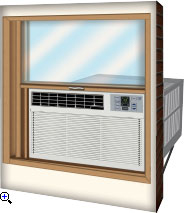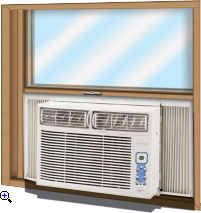Installing an Air Conditioner into a Window
Window air conditioners are single, self-contained units that exhaust heat and humidity from the room to the outside. They have louvers on the back and sides that bring in fresh air. The air runs through coils, which are cooled by the compressor using refrigerant, and then the fan pushes the cool air back into the room.
How do I choose a window air conditioner?
The four most important things to keep in mind are window type, window size, BTUs and plug type. Window Type There are three different window types - standard windows (single and double hung) that slide up and down, slider windows that slide left and right, and casement windows that swing out. One style of air conditioner will go through a standard window, and taller, thinner models air will go through a slider or casement window. All air conditioners will come with a window installation kit with accordions to block the excess space on one or both sides of the unit. For slider and casement windows, if you have a particularly tall window you may need to purchase additional Plexiglas, wood or another filler to seal the space above the air conditioner.
 |
 |
 |
|
Window Size You need to measure width, height, and depth. Please measure twice and order once. You have to support a window air conditioner either from the bottom with a bracket to the exterior wall, the sides with a window kit or both. If you are installing the air conditioner with a window kit, it's important that you account for at least three to four inches for the accordians to fit into the space between the window and the air conditioner.
BTUs (British Thermal Units) BTUs are units of power - the larger the area you need to cool, the more BTUs you need. It's important to find the right size. Buying a higher BTU air conditioner than your room size requires is not recommended. It is preferred to have the correct size air conditioner run for longer to properly remove humidity from the room - learn more. Plug Type There are two parts to plug type: voltage and amperage. Most rooms have circuits rated for a total of 15 amps of electricity, and many units have common 125V/15A plugs that can be used in most homes. If you are installing a larger unit with higher than 15 amps and more than 125 volts you may need to call an electrician to upgrade your circuitry. If you are replacing an existing unit, choose an air conditioner with same plug type to determine the right amount of amperage and voltage.
What are the pros and cons of a window air conditioner?
Window air conditioners require very little installation and you can normally install them yourself so there is low upfront cost. They are a good choice and are energy efficient if you are cooling one or two rooms and there are many to choose from.
Most window air conditioners are quiet but, since the whole system is contained in one unit they can be louder than split type air conditioners where the compressor sits outside. Window air conditioners obstruct at least part of one window and you need to either remove them or winterize them for the colder times of years.
How do I install a window air conditioner?
All window air conditioners come with a window installation kit which most people can install without professional help by sliding the unit into their window. Units with larger BTU capacity (usually 10,000 BTUs and up) are too dangerous to install in one piece because they are much heavier - these units will have a slide-out chassis. A chassis is the framework that supports the guts of the air conditioner. The chassis is designed to slide away from the back of the unit, which is called a sleeve. You remove the chassis and install the sleeve into the window. Then, you secure a bracket supporting the sleeve to the exterior wall. After the back of the unit is secure, you slide the chassis back into the sleeve.
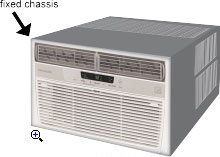 |
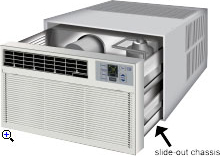 |
|
Can a window air conditioner go through a wall?
Depending on the thickness of your wall, air conditioners with a slide-out chassis can go through a wall. You may need to install brackets to support the sleeve within the wall. You must check the thickness of your wall and the depth from the edge to the louvers of the air conditioner.
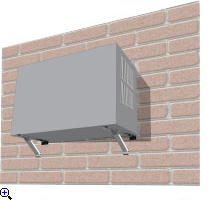 |
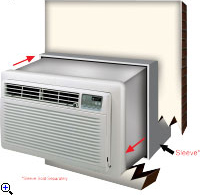 |
|
| Outside View | Inside View |
Do some window air conditioners have heat?
Yes. There are two different type of heat. Some window air conditioners have electric heat strips and a few have heat pumps - learn more.
